New here? Hi! To unlock the many dozens of recipes, video links, product recommendations and other newsletters from my kitchen, all you have to do is subscribe. <3
Hello Comrades!
The purpose of this newsletter is to convince you that kitchen organization is super sexy.
I learned about the beauty of using the fewest motions and taking the least amount of steps in 1998 and 1999, when I worked at Montrachet, in NYC’s Tribeca (RIP). Montrachet had a tiny kitchen—the three of us line cooks stood hip to hip during dinner service. On night one I realized I had to keep my elbows tucked close to my body when turning back and forth from the range to the stainless-steel counter. If not, I’d rib check my neighbor and send a hot skillet flying.
I’ve lived in the same house in Brooklyn since 1999. The kitchen is galley-style, diminutive in footprint and finite in storage, and I had 20 years of meal prep experience in it before it underwent a big overhaul in 2020. The basic footprint and layout didn’t change, but every inch of cabinet space and all of the surfaces were ripped out and redesigned with the incredible architecture team at Varlands. From the start, I was super intentional about where everything would live, and obsessed with solving some of the inefficiencies I’d become increasingly annoyed at over the years. (In fact, Jaclyn Shark Varland made sure the height and depth of the cabinets would accommodate everything I intended to store, a level of detail that I’m still floored by, five years later.)
Between 1999, when I moved in, and 2020, when we renovated, I had learned a lot about kitchen flow, restaurant organization, and how I cooked. I knew that the four main kitchen zones could be simplified into these categories: PREP, COOK, EAT, CLEAN. Everything in the kitchen needed to be funneled into one of those buckets. That was the jump-off point.
Figuring out where everything would be stored went hand-in-hand with determining where I would be, physically, when doing specific kitchen tasks. Of course I wanted my kitchen to be fun and efficient to cook in, but it was also important to me that mundane tasks, such as putting away groceries and setting the table, weren’t so incredibly irritating that I’d never want to shop, eat, or clean again.
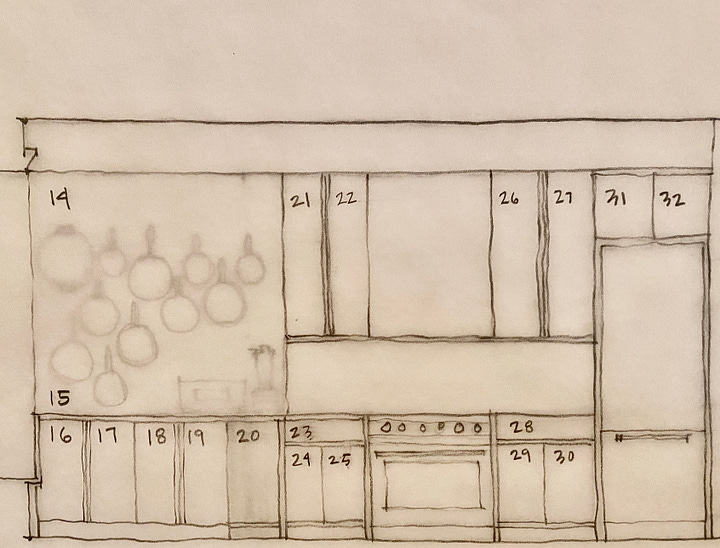

While I had the benefit of a clean slate when I packed everything up, purged, and renovated, the same broad thinking can be applied to any kitchen, big or small. To start, divide your kitchen using the PREP, COOK, EAT, CLEAN philosophy. When you classify your kitchen contents this way, it takes all the guesswork or randomness out of where things go. Adult humans, like toddlers, like sorting exercises, and it will be pretty obvious what items should live together in your drawers and cabinets.
But before you start putting things away, decide where it makes the most sense for you to be—physically!—when you are prepping, cooking, cleaning, and eating. In other words: don’t let your cabinets dictate your storage. Decide where you want to stand when you are doing things, and back into the organization from there.
For example, CLEAN. Whether you have a dishwasher or not, cleaning is a sink-adjacent activity, with some amount of counter space needed for air-drying, storage for cleaning supplies, and ideally a garbage for scraping food.
When you PREP, you need access to your cutting boards, knives, small tools (peelers, digital scale, cheese grater, strainer, measuring spoons and cups), plus mixing bowls and rimmed baking sheets. In my case, there’s also a ruler so I can make a note of how thick or thin my slices are while I’m writing up recipes.
In a small kitchen with limited counter space, you might prep on the same stretch of real estate that’s zoned for air-drying dishes. Something to think about. It’s helpful to be close to the fridge for prep, since that’s where you grab some ingredients from, but not essential. In my case, the fridge is at the opposite end, so I try to grab multiple things at a time and squirrel them over to my area when I’m getting started (anyone who’s worked as a line cook is familiar with the idea of hitting the walk-in for as many ingredients as possible before setting up their station).
In my kitchen, I wanted to be able to prep meals without people (aka my children) walking back and forth behind me to get what they need for setting the table. That led to a decision to put the prep area at the dead end of the kitchen by the window, situated above a lower cabinet dedicated to mixing bowls, colanders, measuring cups, salad spinner, and the mini-chopper. There’s a drawer for small tools, and a second drawer for kitchen towels. I banished cups, glasses, plates, everyday bowls, and silverware to the other end, closer to our dining table, aka the EAT zone. When I’m at my corner seasoning veggies that are about to get roasted, or slicing pork chops after they’ve rested, the boys can float in and out and set the table. If I’m working on recipes during the day, the eating area is open for snack making and beverage drinking.
This has turned out to be great when people come over, too. My prep zone has its own geography, so I can stage a little self-service drink area for friends/fam at the other end of the counter, without compromising the user-friendliness of either area.
It makes sense to put pantry items near prep—in the same way that it’s nice to have the fridge nearby. My pantry (aka dry storage) is divided into two areas: wet dry, and dry dry. I wrote about what the hell that means in Where Cooking Begins, and made a video about it, too. Linked!
Finally, we can COOK. This department has three overlapping priorities: cooking vessels and tools; high-touch ingredients; and the fire/heat source.
If you’re a line cook, you want your skillets and sauce pots to be right next to or hanging above the range so that you don’t have to go anywhere to throw a sauté pan on the fire. Same at home. Group your cooking equipment—pots and pans, Dutch ovens and sauce pots—near where you want to be when you start making something. Wooden spoons, spatulas, ladles, and whisks should also be within reach (I prefer them in a canister on the counter rather than in a drawer; one less movement when grabbing).
COOK is also the best place for your kitchen caddy. Whether it’s on a tray or a lazy Susan, the caddy is home to high-touch cooking ingredients, such as oil, vinegar, and soy sauce, salt and pepper, frequently-used spices such as MSG, chile flakes, and nutritional yeast. Vintage-era video linked!
This all sounds great and perfect, but in reality it’s going to force you to make some choices.
High-touch items deserve high-value locations. For example, I just did this exercise with my dear friend and video guest-star Ross, who recently moved into a new apartment with a pretty small kitchen. Before I intervened, Ross had put all of his bar items—bottles of booze, shakers, jiggers, etc.—in a primo cabinet right over the range. Everything fit, but he plays bartender about once every couple of months. That’s not often enough to justify sacrificing one of three (total) upper cabinets. We moved the bar inventory to a shelf near his dining area, where he can get to it when he entertains. The cabinet is now home to his morning routine, which takes place under cover of darkness at 4:30 A.M.: ingredients and tools for his coffee, smoothie, and meal prep.
In my kitchen, I didn’t want to give up counter space to my stand mixer, which I use twice a month or less—it lives with the vacuum cleaner and trash bags and other miscellany. It’s sort of annoying to get it out, but because that’s infrequent, it’s no big.
You might discover that you have more pots and pans than you have storage for. Same with a closet and pants! First thing I’d do is take a hard look at your supplies and see if you have items of the same size or shape. You might have to say goodbye to one of them. Been there! Do you have equipment you’ve upgraded, but held onto the original? You can donate the one that you don’t use anymore. Do you have a bulky rice cooker and cabinet-hogging Instant Pot that both need a home? This town might not be big enough for the both of them. Maybe one goes into a closet with my stand mixer? Maybe you make hard choices (my rice cooker triumphed over my pressure cooker when I had to make Sophie’s Carla’s Choice).
Short on upper cabinet space? Peg boards are awesome. Short on counter space? A rolling butcher block is a combo surface-and-storage solution (Ross is making good use of his). Lots of skillets with limited real estate? Stack them, widest on the bottom, smallest on the top.
I love my small-ish kitchen, where I’ve cooked countless meals for family, friends, and holidays. I’ve also produced recipes for three cookbooks, this newsletter, and shot about 200 recipe videos there. It works.
Maybe I’m just used to taking fewer steps, but I believe that there are many advantages to having limited space to work in versus the luxury of a gigantic kitchen. On the other hand, I’d love to have enough space for a little table to eat at in my kitchen, which I don’t have now. But on the other other hand, the boys and I love our casual little stand-up dinners at the counter. On the other other other hand, I fantasize about a walk-in pantry the way other people pine for walk-in closets. Do I have a Pinterest board called “Imaginary Kitchen”? Well yes, yes I do!
Thoughts on your dream kitchen or genius storage ideas? Let’s hear about it!


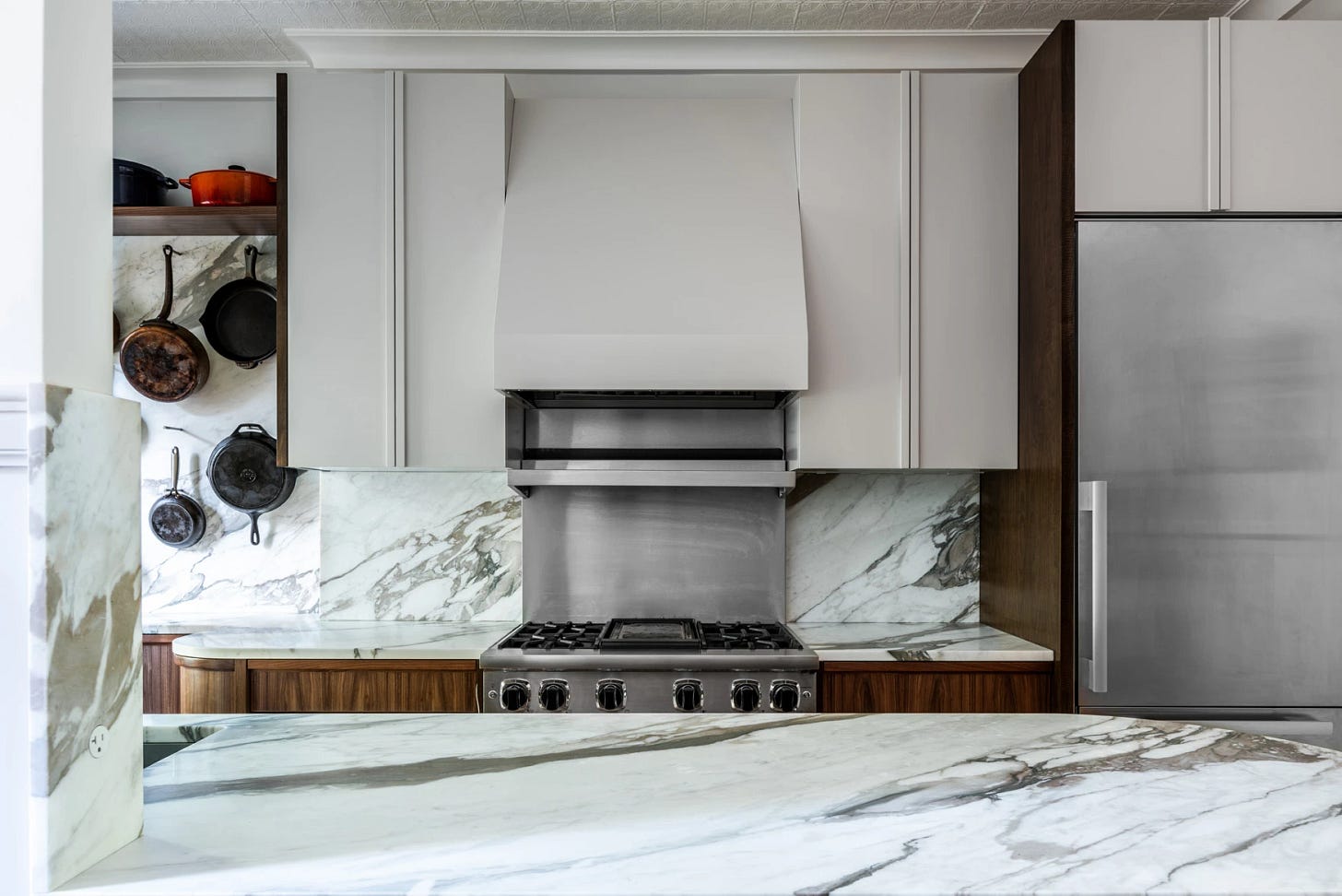
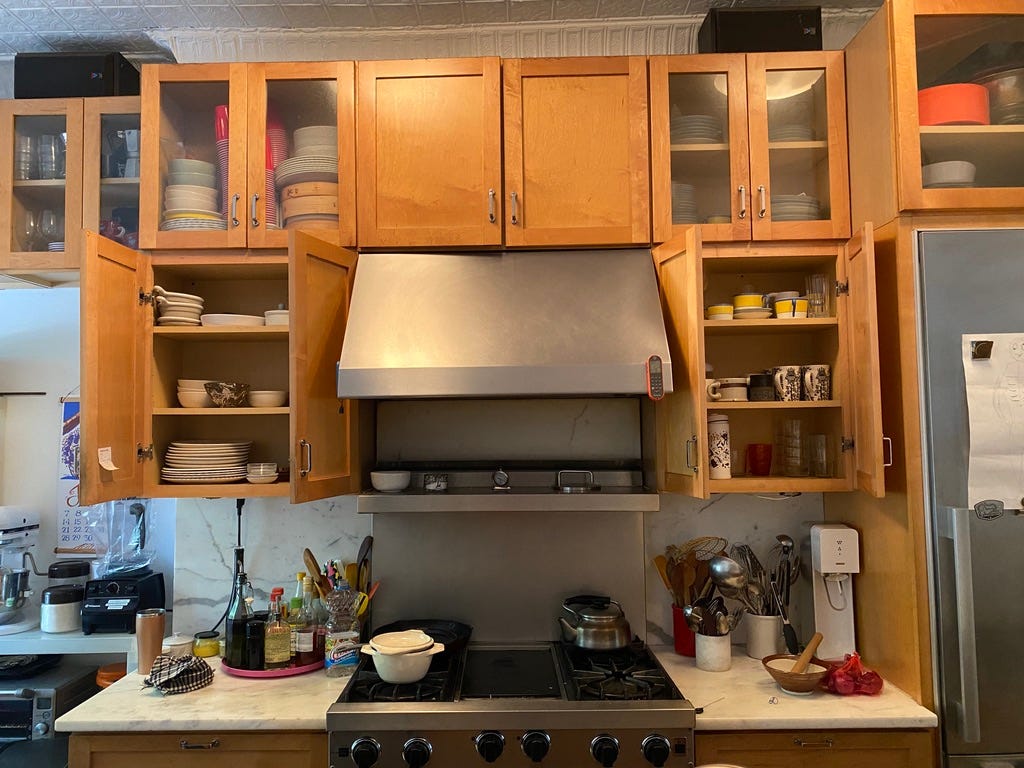

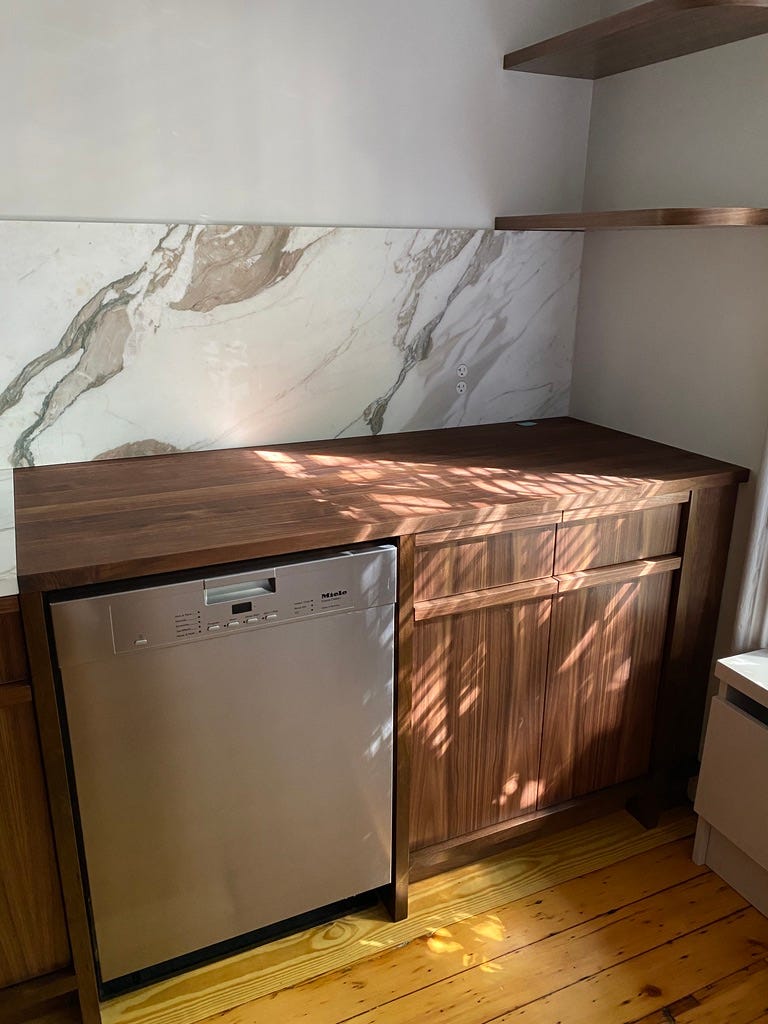


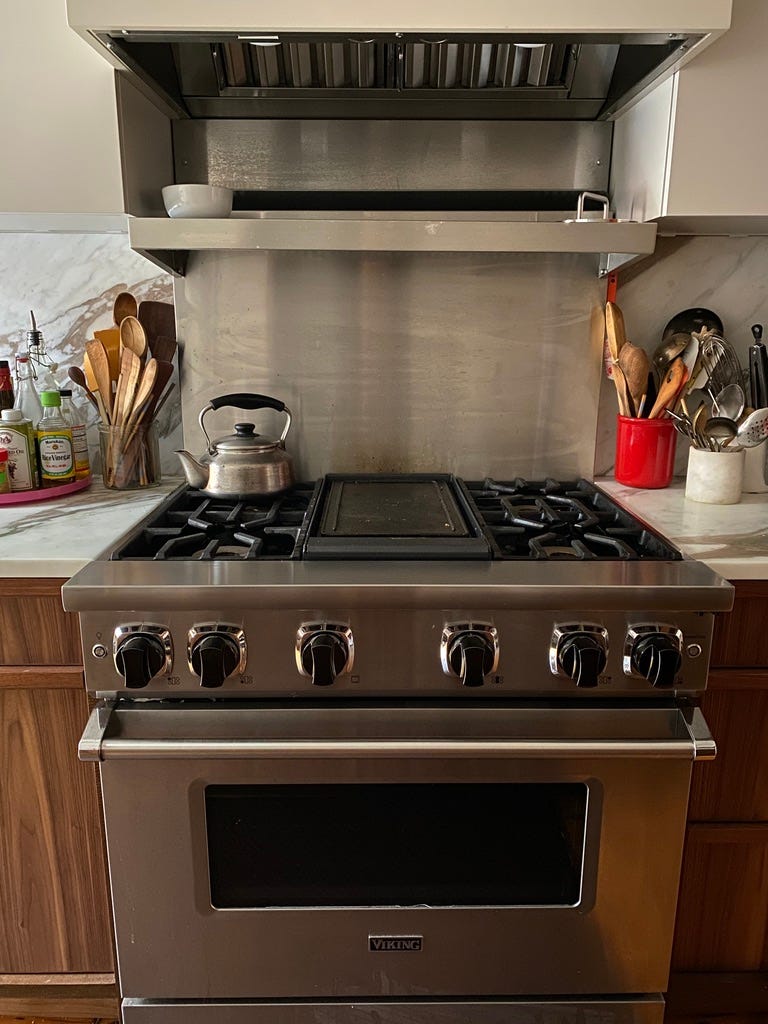
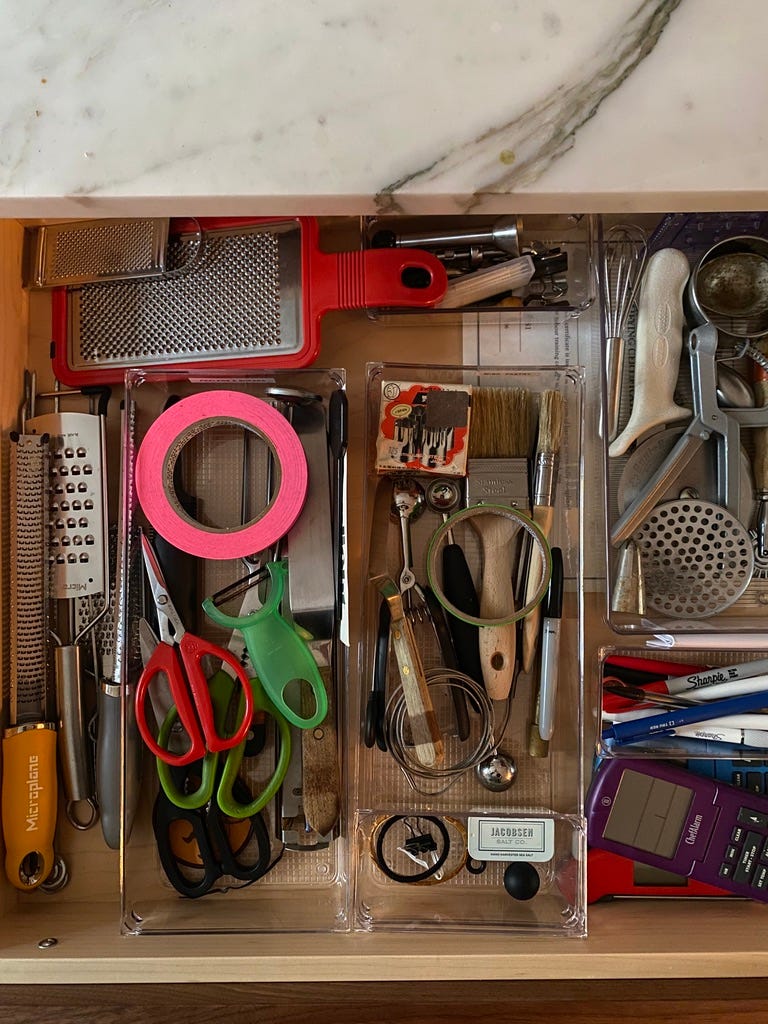
I read this with a sense of smug satisfaction, knowing that my small kitchen is set up with a similar sense of purpose: crocks of cooking utensils on the counter next to the stove, Kitchenaid and Cuisinart not taking up valuable real estate on the counter because I use them infrequently, knives neatly lined up on my magnetic knife rail on the side of my fridge.
Please give us a tour of your dry goods storage next! I have one very tall upper cabinet for all my dry goods and even with shelf helpers and lexan bins to corral all my spices it's a nightmare in there.
there are some things you just cannot unlearn from working in restaurant kitchens, and aggressive efficiency is one of them. the other is standing and eating where you prepped and cooked 🥲 (or maybe that’s just me, in my tiny galley kitchen).
this is so great- thanks for writing. will print and hand to the designer of my future dream cottage.